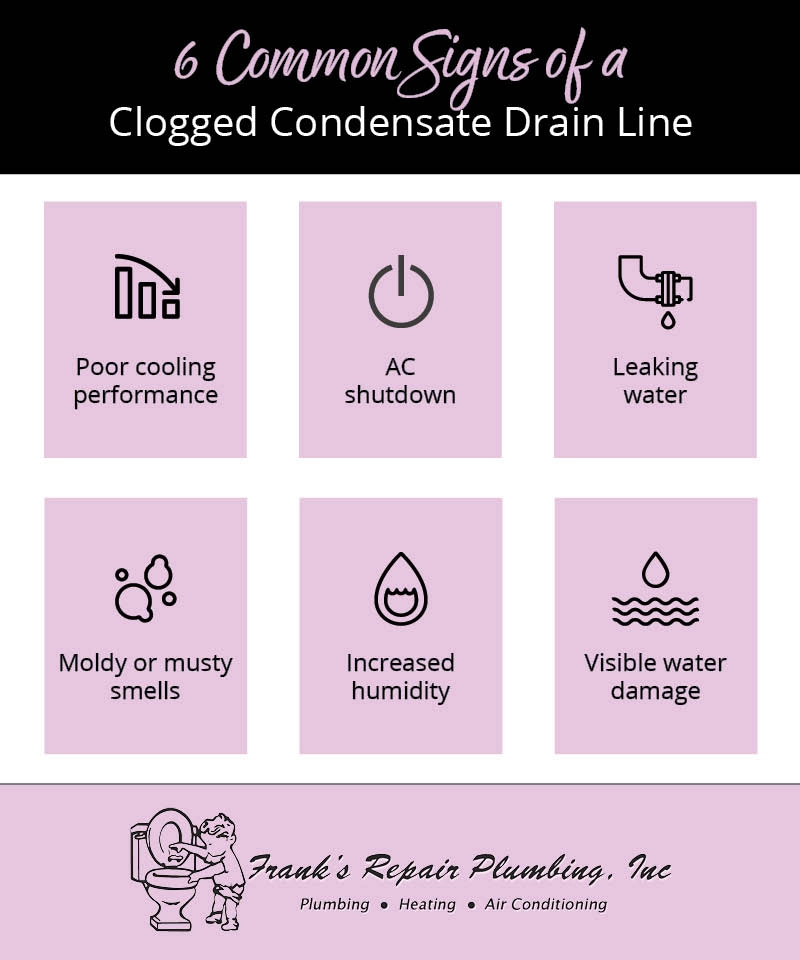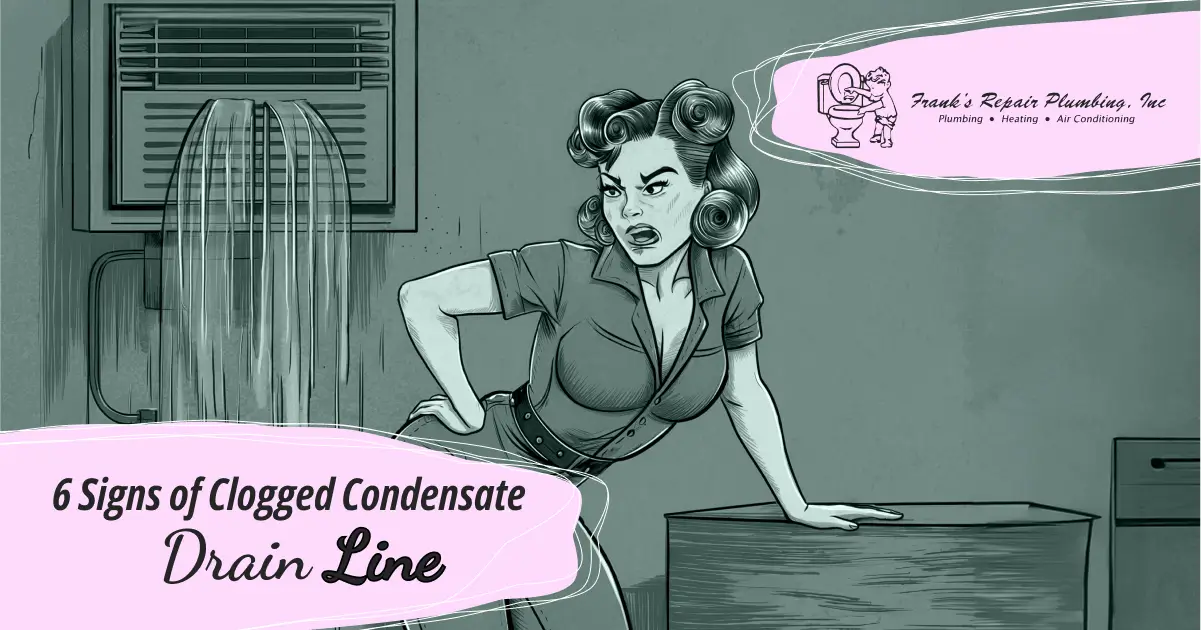What’s in This Guide:
- Purpose of the Condensate Drain Line
- Common Signs of a Clogged Condensate Drain Line
- What to Do if Your Condensate Drain Line is Clogged
- How to Prevent Condensate Drain Line from Clogging
- Frequently Asked Questions
A clogged condensate drain line is more than an inconvenience — it can prevent your AC from properly cooling your home during peak Texas temperatures in the summer and also lead to water damage and AC system breakdown if left unaddressed.
Purpose of the Condensate Drain Line
Air conditioners draw in warm air, cool it with the evaporator coil, and redistribute the conditioned air throughout your home. During this process, the AC unit draws humidity from the air and creates condensation. The condensate drain pan catches dripping condensation and transports it to the outdoor unit where it drains.
The condensate drain line connects the condensate drain pan and the outdoor air conditioner unit. This part of your AC system is essential as it keeps water or excessive humidity from accumulating in or around your system.
Common Signs of a Clogged Condensate Drain Line
Knowing the signs of a clogged drain line can help you and your HVAC identify and address underlying problems sooner, preventing escalated damages and repairs.

1. Poor cooling performance
A clogged condensate drain line can impact your AC system’s cooling performance. Excessive moisture that’s unable to drain away can cause ice to form on the evaporator coil, preventing the system from properly cooling air.
2. AC shutdown
Some AC systems feature a safety float switch that triggers when it detects excessive humidity or water. These sensors may detect when the drain pan overflows from a clogged AC drain line and trigger a shutdown to prevent further damage.
3. Leaking water
Water pooling around the AC unit is a clear indicator of a clogged condensate drain line. If the drain pan can’t drain water away, it’ll eventually overflow and leak water around the indoor unit.
4. Moldy or musty smells
Humid environments allow mold and mildew to thrive. When the drain line backs up and circulates excessive moisture throughout the system, mold can grow in the ductwork, air handler, and other areas, leading to unpleasant musty smells and spore-contaminated indoor air.
5. Increased humidity
High humidity levels from poor drainage can cause condensation to build up on your ductwork and other AC equipment. While some condensation is acceptable, excessive amounts can lead to leaks.
6. Visible water damage
Pooling water and leaks can cause water damage around your air conditioner unit and its equipment. Likewise, high humidity can gradually warp and discolor walls, ceilings, and floors throughout your home.
What to Do if Your Condensate Drain Line is Clogged
Prompt action is important if signs in your home point to a clogged condensate drain line. Depending on your HVAC knowledge and skill and the severity of the clog, you may be able to unclog the AC drain line.
If you’re confident in your skills, follow these steps to unclog your condensate drain line:
- Turn off power: Switch your air conditioner off to prevent it from running during the repair. Disconnecting it from the electrical panel can help prevent someone in your household from mistakenly switching the unit back on.
- Locate access point: Find the access point for your drain line, typically located near the outdoor condenser unit or indoor air handler. Look for a PVC pipe with a T-shaped access point.
- Inspect the drain line: Remove the access cap to inspect for obvious clogs or blockages. Using gloves, remove small blockages if possible.
- Clear the blockage: Pour a solution of water and vinegar into the drain line, and let it sit for at least 30 minutes to break down debris.
- Flush with water: Pour water into the drain line to flush out the vinegar solution and clogging debris. Continue flushing the drain line with water until the water flows out clearly and consistently.
Some AC condensate drain line clogs are too stubborn for DIY flushing solutions. If the clog persists, call a licensed HVAC technician for assistance. With specialized tools, knowledge, and experience, HVAC technicians can efficiently diagnose and resolve condensate drain line clogs. They can also inspect your system for underlying AC repair or maintenance needs that may contribute to clogging problems.
How to Prevent Condensate Drain Line from Clogging
Several factors can lead to clogs in your condensate drain line. Dirt, dust, leaves, and other debris can easily enter the drain line. Underlying inefficiencies or problems in your system can strain its components, leading to a chain reaction of problems that may eventually cause a clog. Algae and mold can also cause clogs — in some cases, HVAC technicians may add algaecides or other treatments to prevent mold and bacteria growth.
Preventative strategies can help you avoid the inconvenience of a clogged drain line. Try these steps to keep your AC system and drain line running smoothly:
- Regular maintenance: Schedule seasonal maintenance with a qualified HVAC technician for a thorough inspection, cleaning, and adjustment of your system’s components.
- Change filters: Dirty air filters can reduce airflow and encourage dust and debris buildup in your system. Replace air filters at least every 12 weeks.
- Clean outdoor unit: Keep the outdoor unit clear of leaves, sticks, and other debris that can block proper drainage.
- DIY maintenance: Flush your system with vinegar periodically to clear away debris before it escalates to full blockages. Complete this task more frequently if you have pets, live in a humid climate, or have an older AC unit.
Call Frank’s Repair Plumbing for HVAC Repair in the Texas Panhandle
Serving Amarillo, White Deer, and areas across the Texas Panhandle, Frank’s Repair Plumbing provides expert HVAC repair and other services. Whether you need air conditioning, heating, or plumbing services, our team of state-licensed and NATE-certified professionals is available for routine and emergency services. Contact us today to schedule AC repair and maintenance.
Frequently Asked Questions
What are the risks of ignoring a clogged condensate drain line?
Ignoring a clogged condensate drain line can lead to mold growth, poor indoor air quality, reduced AC performance, and further damage to your system. In severe cases, clogs can cause water damage to your home’s structure.
How much water should drain from an air conditioner?
Depending on humidity, Air conditioners typically drain up to 20 gallons of water per day during peak cooling season in Texas.


